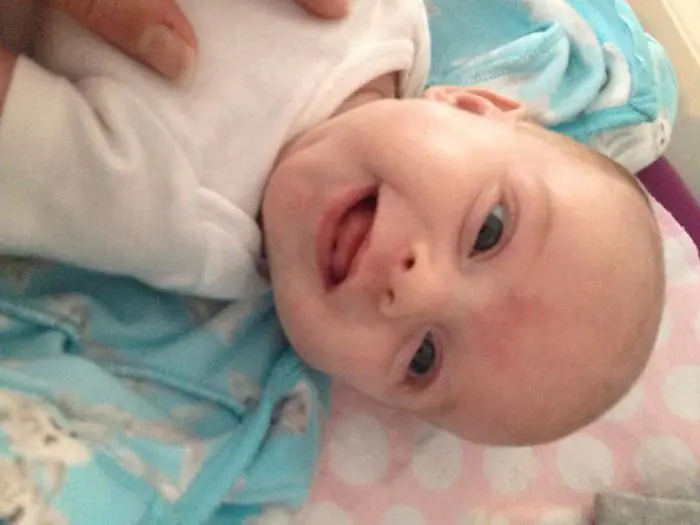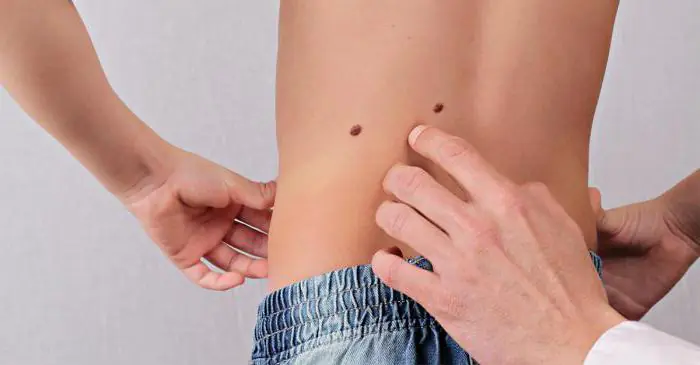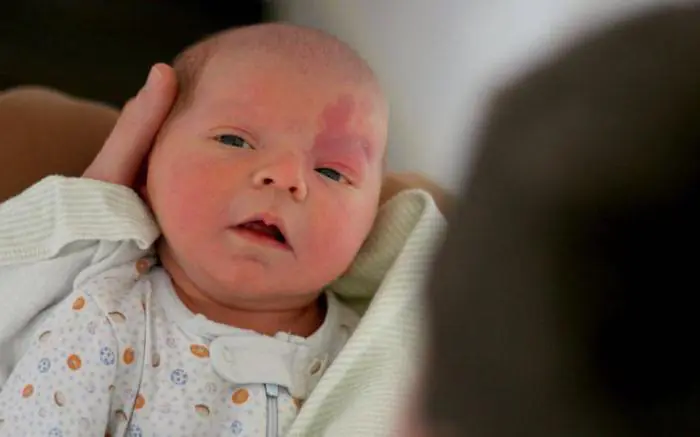Moles (or nevi, in scientific terms) are an absolutely normal phenomenon. By themselves, they are completely harmless and do not cause any harm to health, but there are those that begin to grow unevenly or change color. Such neoplasms require increased attention and can cause the development of a malignant tumor if they are not removed in time. The prognosis is positive: in 95% of cases, patients recover. But if you don’t pay attention to the changed mole and waste time, there will be only a 20% chance.
As for children, they also have moles, but there are very few cases of dangerous degeneration of a nevus into an unfavorable form in young patients in medical practice. Moles, as a rule, do not appear from birth, although there are exceptions (in such cases they speak of birthmarks, not moles). So when do moles appear in children? Can neoplasms be dangerous? Why do moles appear in a child? Let's look at these questions in more detail below.

Moles in newborns
Very few children are born with moles on their body, and if such spots are observed, they are rather called birthmarks. Birthmarks, by the way, “grow” with the child; this is normal and should not cause concern.
Moles got their name not from the time they appeared on the human body (immediately after birth), but rather for another reason: because nevi are transmitted genetically, i.e. if the parents’ body is covered with such spots, then the grown-up child will most likely will face the same thing.
At what age do moles appear? On the body of a newborn, nevi can be barely noticeable and very light, indistinguishable, so that parents will notice them only when the child grows up. The predisposition to the appearance of nevi, as already mentioned, is transmitted genetically, that is, even before birth, a certain number of such marks are “laid” on the body.

If we talk about newborns, then most often premature and fair-skinned children are born with moles (birthmarks). Girls are born with brown spots approximately four to five times more often than boys.
From six months to two years
When do moles appear in children? Many parents begin to notice new growths on the skin of their babies from six months to two years. But here, of course, everything is individual and depends on many factors (genetics, exposure to the sun and the pace of development of the child - this will be discussed in more detail later), and not just on age.
From the age of six months, they usually begin to slowly take the child with them to the dacha, the beach or a picnic, and go on longer walks. Even a couple of hours of exposure to sunlight is enough for a mole to appear that was not visible before. As a rule, daily walks are enough, since the appearance of tumors is caused by ultraviolet rays.
If you are alarmed by the fact that your child has moles on his body or if you think there are too many “spots”, contact your local pediatrician or immediately see a dermatologist. The specialist will examine the child and tell you whether there is a danger. You should also contact a dermatologist if you notice two or three large moles (more than 5 mm in diameter). It is worth mentioning here that nevi that degenerate into malignant formations are extremely rare in children.

From five to seven years old
What time do children get moles? The next wave of active appearance of neoplasms is observed at five to six years. This is a period of rapid growth of a little man, when all organs and systems are actively improving, and the adaptive properties of the body are significantly improving. In just one year, a child can gain height and weight as rapidly as babies in their first year of life. Pediatricians even call the age of five to seven years the period of “first physical traction.” So it is not surprising if a child has a lot of moles at the age of five to seven.
During adolescence
When do moles appear in children? In adolescence, hormones interfere with the formation of nevi, which, as a rule, sharply increases the number of moles. It is generally accepted that during puberty (that is, at about twelve to fifteen years old) and before twenty-five, 80% of moles appear that will accompany a person throughout his life.

Causes of moles
The number of neoplasms and the age at which they appear directly depends on several factors. At the moment, doctors identify three main reasons:
- Genetic predisposition. A child inherits a tendency towards neoplasms from his parents; in addition, if a mother or father develops moles only in adulthood, then most likely the child will also encounter nevi only as an adult.
- Exposure to ultraviolet rays. Parents who are worried that their child is developing moles on his face or body should be wary of this reason. Prolonged exposure to the sun significantly increases the risk of dangerous degeneration of birthmarks, so for walks you need to choose the right places (shaded), do not forget about products with an SPF factor and a hat.
- Hormonal changes. Moles appear in large numbers during adolescence, when hormonal levels change. The number of nevi may increase during pregnancy, menopause, illness or prolonged stress.

Vascular moles in a child
Vascular moles are made up of a large number of small blood vessels. They are usually red in color and can range from light pink to deep, bright red. Such neoplasms can be either flat or convex. If a child has a red mole, it won’t hurt to go to the doctor, but, as a rule, these are benign neoplasms that pose absolutely no health hazard. The dermatologist may recommend removing the nevus due to its unsightly appearance, which may subsequently cause embarrassment or discomfort in the child, especially if the red mole is located on the face or in a visible place.
Common nevi
Regular (non-vascular) moles have a smooth surface and range in color from light brown to black. Such nevi can be either convex or flat. As a rule, hairs growing from a mole are a good sign. You should only worry if the tumors are located in the palms or soles, or in the folds of the skin, as they are easy to damage.
Hemangiomas
Hemangioma is a type of vascular nevus. When do moles appear in children? Such neoplasms are difficult to detect on the body of a newborn; as a rule, they appear several weeks or months after birth. Moles are located in different areas and can grow quickly, but most disappear by the age of ten. It won’t hurt to consult a dermatologist or pediatrician, but parents shouldn’t immediately think about removing such a tumor.
"Wine Stains"
A flaming nevus, or port-wine stain, is a flat, red growth that appears on the face or scalp. As the child grows, the “spot” increases in size. Such neoplasms, fortunately, are amenable to physiotherapeutic treatment using laser therapy or infrared radiation, but removing them using radical methods, as doctors say, is not always desirable. However, a mole can disappear on its own as the child grows and develops.

"Stork Bites"
Salmon-colored birthmarks that are localized in the occipital region, on the bridge of the nose or eyelids are called “stork bites” or “angel kisses.” Outwardly, such moles look like a pink spot or a cluster of many small spots.
Medicine explains the appearance of such moles much more prosaically. The thing is that the baby in the uterus is under pressure from the muscular wall and bones of the mother’s pelvis. In places where the pressure is too strong, insufficient blood supply to the tissues or “focal ischemia” occurs.
At what age do children get moles? They've been like this since birth. Over time, the “stork bites” fade, but become brighter when the child is under great stress or anxiety. They usually disappear completely by the age of five, but in rare cases they persist for life.
These nevi do not have any negative consequences for the child’s health; the only problem is a cosmetic defect, and only if the “bite” is too bright. “Stork bites” do not require special treatment; as a rule, they fade as the child grows older and finally disappear after a few years.

Monitoring moles
Moles need to be monitored so as not to miss the moment of their possible degeneration into a malignant neoplasm. Do not cover nevi with adhesive tape, expose them to prolonged exposure to sunlight, or allow injury. If a mole changes color, grows in size, or changes in any other way (this is more common in adolescence or adulthood than in childhood), you should see a dermatologist. The doctor will examine the disturbing growth and tell you whether you need to worry about this wire. The specialist will also suggest (if necessary) a suitable method for removing the nevus.
Many parents are interested in what to do when their children have moles? These formations do not cause any particular inconvenience, but in certain situations they can degenerate into malignant ones. Special attention must be paid. What to do with condylomas in a child?
When do moles appear?
Almost all newborn babies do not have marks on the skin. This is possible only in rare cases. At what age do spots appear in children? Experts distinguish several age periods.
- The first moles in children can appear between six months and one year.
- The second period is observed from five to six years.
- Many moles appear in adolescence due to hormonal changes in the body.
It is impossible to name the exact age at which children develop pezhins.
Causes and symptoms of appearance in children
Why do moles appear in a child? The reasons for this phenomenon are different.
- Hereditary factor. If the baby’s parents have enough birthmarks, they will also appear on him. Some birthmarks are inherited for many generations.
- Hormonal changes. They appear infrequently in childhood, but this factor should not be excluded.
- Another reason why pimples appear on a child’s body is prolonged exposure to the sun.
Factors that provoke the appearance of birthmarks include diseases of the gastrointestinal tract, nervous shock, and infectious diseases. For the same reasons, a baby may develop a white spot around a mole. What does it mean? Do not be afraid of this phenomenon; if itching, peeling and painful sensations appear, you should visit a specialist. What symptoms are characteristic in this case?
- Correct shape, no blurred boundaries,
- Color from light beige to dark brown,
- No pain, itching,
- Condyloma can be slightly convex or flat,
- Education increases in size as the child grows.
In the absence of any unpleasant sensations or signs, nothing is done with the nevi. If the growth grows, itches, or becomes inflamed, you should contact a medical facility.
Moles in infants under one year of age
In infants, nevi are practically no different. In certain situations they can have a rather rich color. Birthmarks are more often diagnosed in female babies than in male babies. Experts distinguish two types of pezhins in infants.
- Regular. Smooth condylomas with a beige to brown tint. In the absence of suspicious symptoms, there is no cause for concern.
- Vascular. Appear as a result of the fusion of blood vessels or capillaries. Pejina can be smooth or convex. Color varies from pink to red. Sometimes they can increase in size and must be removed if they cause discomfort (on the face).
A red mole on a baby's face or other part of the body should not cause much concern. In certain cases, the nevus may disappear on its own.
Types of moles
Experts identify several types of moles in children.
- Intradermal. They represent a spot on the skin or rise slightly above it. They come in the same color as the skin or darker (black).
- Borderline. A convex mole with regular shape and dark color. Does not cause discomfort to the owner.
- Mixed. Growths similar to a dark ball. The size is approximately one centimeter.
- Congenital. This type appears in the baby while in the womb.
The most dangerous moles for a child
What nevi pose a danger to a child? In most cases, these condylomas are benign in nature. However, under the influence of certain factors they can degenerate into malignant ones. Therefore, parents should carefully monitor the condition of their child’s birthmarks. What should you pay attention to?
- Education changes its shape, the boundaries become blurred and uneven.
- The child has many moles, they have different colors, and new ones appear periodically.
- Rapid growth of pezhin, achieving large sizes.
- Peeling, itching, pain.
Having discovered these signs, it is necessary to show the child to a specialist.
If a child picks off a mole or scratches it, it is necessary to treat the damaged area with hydrogen peroxide and also consult a doctor.
Doctor about baby growths - video
Is it possible to remove stains: treatment
Quite often, removal of the formation is quite justified. A laser is used for this. The procedure is prescribed after a complete diagnosis, as well as in case of possible transformation into a malignant tumor. Nevi that are subject to frequent damage (moles on the head, neck, armpits) are removed.
The procedure is performed in a medical facility under local anesthesia. In some cases, general anesthesia may be used.
Upon completion of the process, the formation is sent for histological examination. Is it possible or not to remove moles in general?
Conservative treatment in children is quite rare. The same drugs are used as for therapy in an adult, but the appropriate dosage is selected. This type of treatment is often chosen for red moles. For large red nevi, specialists may prescribe hormone therapy.
Traditional methods of treatment can also be used. The mole is lubricated with lemon juice, onion, garlic, honey and hydrogen peroxide. However, such therapy should be carried out with caution. Children's skin is very sensitive, and various allergic reactions are possible.
Who to contact and prevention
Which doctor should I show my baby if the pimples appear quite often or become inflamed? Who should I turn to for help? First of all, you should visit a pediatrician who will give you the necessary referrals to other specialists. Parents should monitor how moles appear on their children and whether they cause discomfort.
- Large formations must be constantly monitored.
- If there is an inflammatory process on the nevus, the appearance of purulent discharge, dry crusts, you need to visit the hospital.
- It is necessary to cover areas with moles when in the sun.
- If a child has damaged a mole, then only peroxide or chlorhexidine can be used for treatment. Do not cover the wound with a band-aid.
When children develop moles, parents may become concerned. However, in the absence of suspicious symptoms and discomfort, you should not worry. Every person has moles; they practically do not interfere with normal life.
The appearance of moles in children - video
Modern science cannot answer the question of where moles come from on children’s bodies. Some children have spots on their bodies from birth, while others develop them over time. But there are also those who are lucky to have clear skin.
Doctors never stop saying that it’s all due to heredity, namely genes passed on from generation to generation. Multiple moles can appear without causing harm, but can also be dangerous if they are cancerous.
What types of nevus occur in the plural?
Nevus has the following forms:
Borderline and complex forms often appear in the plural. Complex nevi often reach 10 millimeters or more. They are characterized by a dense consistency and spherical shape. Often such a nevus is called mixed due to its original color.
The borderline type of nevus is considered to be uniform, pigmented spots with an oval or round shape. Such spots have a clear border and a smooth surface. There is no hair on such nevi.
And they arise from birth. Localization includes the torso, neck, face, and external genitalia. The color range of moles can be different - light brown or dark brown.
Why do many moles appear on a child’s body?
Why does a child have many moles? The process of formation and change in the size of nevi is influenced by such reasons as:
- prolonged exposure to the sun.
- Baby's mobility.
- Predisposition to the formation of moles.
Using genetics, you can determine the age of a child at which spots will begin to appear on his body. This could be 5 or 10 years of life. Many doctors say that nevi in males appear at a more mature age, while in girls they appear from early childhood. Genetics also influences the multiplicity of moles on the child's body.
The size of moles, as well as their number, depends on the presence in the baby’s body of special cells called melanocytes. They are located in the inner layers of the skin. Moles on a child’s body are common.
Therefore, if there are few of them, there is nothing to worry about. However, if you notice how they begin to enlarge and change their color, this is a reason to think about visiting a specialist.
What is dangerous when children have too many of them?
If parents are worried about spots that have appeared on the baby’s body, they should definitely contact a dermatologist or pediatrician. The doctor will conduct an examination and determine how dangerous it is for the child’s health. Malignant pigment spots at a young age are not a common occurrence. But, it is important to ensure that the moles do not become even larger.
It is also important to take into account the child's reaction for such education. Often nevi appear on the skin due to decreased immune defense. This can also cause changes in the size and color of moles.
Often, inflammatory processes can bother a child when birthmarks degenerate. Taking this information into account, we can say that even barely noticeable nevi can be very dangerous.
But don’t sound the alarm ahead of time. Degeneration of moles is quite rare. Moreover, this does not depend on the number of spots that occur on the baby’s body.
In medicine, there is a special classification of nevi. They can be vascular or ordinary. The former differ in their structure, since they contain blood vessels.
Their color can take on different shades - from pink to red. Red moles are not dangerous, but in some cases they are removed because such formations do not look aesthetically pleasing.
The second type of moles is considered common. They often have a smooth surface. They take on a light brown or black tint. and their appearance can be observed in the first years of a child’s life. When hair grows in this area, it is considered a good sign. You need to worry about moles that are located on the palms or soles of your feet.
Should I delete it if the quantity starts to bother me?
Many children develop moles at a very young age. This phenomenon is absolutely normal. You can only be wary if many moles appear in 2-3 months. In this case, it is better to visit a dermatologist or oncologist.
The doctor will examine the moles on the baby’s body and tell you about the reason for their multiple appearance. Often, nevi appear as a reaction to tanning and other external factors. In rare cases, they can talk about pathologies associated with the immune system and diseases of the internal organs.
The indication for removal of moles is the threat of degeneration to cancer. The degree of danger is assessed by an oncologist. Doctors say that you should not touch nevi with your hands, as this can lead to their degeneration.
But often they appear in places where a child can catch them with clothes or shoes. Removing nevi is in some cases a simple necessity. But even after a minor operation, a number of complications associated with bleeding and allergies to anesthesia can occur.
Nowadays, the most popular methods of getting rid of moles are:
- surgical.
- Laser cleaning.
- Use of liquid nitrogen.
- Cauterization with electric current.
- Radio wave.
The choice of method is made by the doctor, since it takes into account the properties of moles. Often, tumors similar to cancer are removed with a scalpel in order to completely rid the body of infections. In other cases, cryodestruction and laser cleaning have become extremely popular. Such methods are considered the safest.
The wound at the site of the mole should be treated until complete healing. Using ointments you can speed up this process. To prevent infection from getting into the wound, you need to take into account the following tips:
- You can’t get the crust wet and tear it off.
- It is important to ensure that the wound does not get exposed to the sun. Before your child goes out into the sun, cover it with a plaster.
If a mole has been removed surgically, then its complete healing can be observed after 2 weeks. As for the other methods, they are less painful and the unpleasant sensations will not last more than 7 days.
It is very rare to observe wound inflammation due to infection. In this case, healing may be delayed, and scars may remain after it.
What should I do to prevent the problem from returning again?
A mole is a congenital malformation of the skin or a benign tumor that forms at different stages of life. The following actions can be taken to prevent nevi:
control over exposure to the sun.Your child should not be under the sun at dangerous times, namely from 11.00 to 16.00. if this cannot be avoided, it is important to wear clothes made from natural fabrics to protect the skin and also to avoid overheating. Don't forget about the need for a headdress.
Using sunscreen.Despite the degree of dark skin, children are exposed to the sun much faster than adults. This is why it is worth applying sun protection cream to exposed areas of the body. Wearing loose and comfortable clothes and shoes from natural materials. Nowadays, many modern parents are trying to buy stylish things for their children.But during the summer season and hot days, it is important to consider not only the beauty, but also the safety of certain items of clothing. Often they protect against the harmful effects of the sun and the appearance of moles.
Conclusion
If multiple moles still appear on your baby’s body, be sure to consult a dermatologist for a detailed examination. This way you can rest assured that your child is not in danger.
Most often, children develop normal nevi that do not cause much discomfort. They do not itch or bleed, which means they have no effect. But it is important to check them too, especially if you notice changes in the size of moles and their color.
To record the changes, it is important to undergo examinations by a doctor in order to avoid any unpleasant consequences. This is the only way you can protect your child from problems with nevi in the future.



